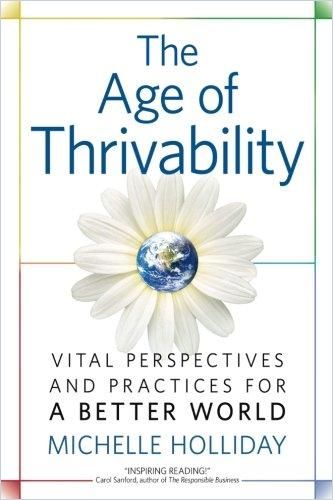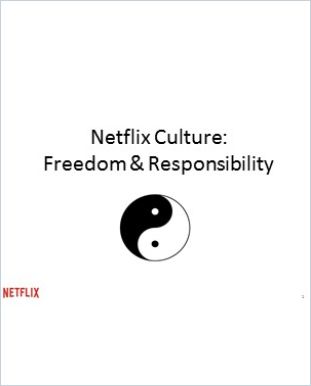“For Creativity and Innovation, Life needs Time and Space”

Most people agree, with the speed of change these days, businesses need to stay agile to survive. But in your book, The Age of Thrivability, you say businesses must look beyond survival to “thrivability.” Can you describe a little bit what you mean by thrivability?
Michelle Holliday: At the most basic level it’s the ability to thrive, as the word suggests. It’s an invitation to make that our intention and our practice, so that the state of being able to thrive is not a single point in time, or a single goal that we can say, “Now we’re thrivable,” and we can quit and go home, or get a prize, “Number One, Most Thrivable Company.” It’s really not about that. It’s much more about orienting ourselves around life’s ability to thrive, most of all, and then committing to that practice. I talk about thrivability as the informed intention and practice of enabling life to thrive, or of cultivating the fertile conditions for life to thrive. Informed, because if we’re going to create those sorts of conditions, we have to know, what does that mean? What does it take? So, we have to develop some level of understanding of how life works and how that shows up in our organization, and then set it as our intention.

And we don’t right now. We don’t have life’s ability to thrive anywhere in our scope of intention in our organizations, or even in government and society. We set our sights on something far less than that. And as a result, we’re getting something far less, disastrously less, catastrophically, extinction-level less than thriving. And next, we commit to an ongoing practice of figuring out what that means for us. I talk about deepening our wisdom and compassion and ability to sense what’s needed, and respond with effective action; it’s an individual and a collective practice.
You’re basically framing these business methods and techniques sort of as a practice, rather than a process. In other words, it’s not a business process that is put in place once and done. It’s a practice that evolves over time.
Exactly. You said methods and techniques, and I would even say there are methods and techniques, and there are processes, but they need to be framed and held within a bigger intention and a bigger understanding of what we’re working on.
How is efficiency in organizations sometimes at odds with creativity and innovation?
Efficiency in itself is a good thing. Our bodies are efficient in many ways. Life is efficient. But when that is the goal, then we get into trouble. When that becomes the priority, it cuts us off from the qualitative aspects of our aliveness, of our organization’s aliveness, and our project’s aliveness, the community’s aliveness. Cuts us off from information that isn’t necessarily quantitative. And it channels us into thinking that speed is the most important thing. But sometimes life needs time and space. Very often life needs time and space, especially when what we want is creativity and innovation.
When we recognize our organizations and communities as living systems, we see we nearly always want creativity and innovation. That’s the practice. We’re always trying to figure out what more can we generate.
We almost always need to create the time and space for sensing what’s truly needed, and that’s not always the fastest, that’s not always the smallest use of time and resources. So part of the practice of deepening in wisdom is to recognize when efficiency is what’s needed, and when it’s counterproductive. This drive for efficiency is rooted in a reductionist, mechanistic, individualistic worldview. That’s the dominant worldview in Western society right now. The Age of Thrivability that I write about carries forward that worldview, but integrates it into a more comprehensive and wiser worldview. It’s asking from a search for wisdom: What is the efficiency that’s needed so that we can make the best and wisest choices? We still want that, but how can we put it in service of the wisest course of action for all life? This is all part of the reframing of efficiency in order to get more innovation and creativity, in other words, more of life’s ability to thrive.
If I’m a business owner and I’m thinking: I have my marketing department, I have my sales department, I have my product development. How can I begin to start thinking of my business more holistically in terms of living systems?
This is a great question. I find examples from nature are sometimes helpful to see the characteristics of living systems in our organization. Lately I talk about soil a lot. We’re starting to understand how important soil is. We depend on it for our existence, for our lives, and it’s in trouble. We only have 50 or 60 growing seasons left. Soil regeneration is the most powerful way to sequester carbon and counteract climate change. People are starting to realize soil is important. At the same time people, scientists and farmers are starting to understand how soil works and to understand that it’s not an inert thing. It’s not that the farmer grows the plant with his or her chemicals and heavy equipment, which is the mechanistic, reductionist view that we’ve had for the past 100 years, but instead, we’re starting to understand that soil is a living system and that the farmer can really only cultivate the fertile conditions for life to do what it does. That’s a helpful metaphor.

In my book, I go into the detail of the four patterns of living systems and how they’re present in soil. We’re starting to understand that there’s so much biodiversity in soil, like in a tablespoon of soil there are so many organisms, it’s like stars in the galaxy. It’s an insane amount of diversity in soil. We know that’s fundamental, that’s critical to its thrivability. We know that those microorganisms work with the dirt, which is just minerals, non-living material, and they secrete what this one scientist calls “snots, slimes and glue,” which is kind of funny. With those secretions, they start to aggregate the minerals in a way that creates passageways through which they can interact with each other and through which air and water can circulate, so that’s the structures and patterns of their interaction, their relationship.
Briefly, can you outline these four patterns?
So, in the patterns of living systems, we’ve first got the diverse parts. Then we need patterns and structures of interaction. When there’s enough diversity and there’s enough interaction and flow of the microorganisms and of air and water and other resources, then this thing happens that another scientist calls “quorum sensing.” Quorum, in a human meeting, is when you have enough people present that you can make a decision and take action. In soil, when they sense they’ve got the right conditions, then they have this phase shift where they’re no longer just a crowd of microorganisms and dirt. Now they are acting together as soil. New capabilities and characteristics emerge. We see the ability to hold water, which doesn’t exist when it’s just microorganism-centered, and to sequester carbon from the atmosphere and grow plants. All of these things happen at the level of the whole living system that is soil.
We’re starting to understand that what powers all of that is life. That it’s self-organizing and self-generating, self-regenerating, self-healing, because it is alive. This is a living system.
The farmer can’t make it happen. The farmer can’t manage it and control it, but he or she can support it and collaborate with it, partner with it. Any living system will always be more elegant and more complex, more capable than we can ever control. This example of soil is a useful one for organizations to understand those patterns. We can clearly see them in organizations, and remind ourselves that it’s really about supporting that elegance and grace and self-generating ability to develop new capabilities and characteristics. Even beyond two heads are better than one, or the whole is more than the sum of its parts. It is, but it’s also a whole different thing than the sum of its parts.
It makes perfect sense to me that you spend time on priming the soil and putting all your nutrients in, and you’re going to get a beautiful whatever it is that you’re growing. But it sounds messy, and maybe you need to have a greater tolerance for failure?
Yes, it is messier. It does require a different mind-set and approach. What we’re starting to understand is that the lack of mess is not really viable. In gardening and farming, the mechanistic and controlling approach involves tilling the soil, digging it up. That destroys those structures that the microorganisms have created. Another thing that we do is put in lots of chemical inputs, and that depletes the soil’s fertility. It’s like a drug addiction. We have to keep putting more and more inputs, and that gets more and more expensive for less and less output.
In the same way that we’re depleting our soils, I think we’re depleting humanity.
It’s leaked out from our organizations. It’s the whole society’s way of operating. The parallel to chemical input that is actually depleting the soil’s ability to thrive, the parallel in our organizations is that urge to control. It diminishes and depletes the human spirit, essentially. Toxic work spaces, stress and tension, and lack of meaning. All of it comes together. And we’re getting burned out. Do you see that too?
Yes, I do. Some companies are very “command and control,” and it can be soul-crushing.
Exactly. I appreciate this connection that we’re making, too, between the depletion of soil and the depletion of the human spirit. In organizations we see that toxic workplaces and toxic cultures and “command and control” are soul crushing. And in broader society, there’s this steady increase year-over-year of what’s called “deaths of despair.” So, it’s death from alcohol and from suicide and from other addictions. You have to pay attention to that trend.
In your book, you continually stress that the “divergent parts” are humans. That’s what makes the organization a living organization, the people in it. Now, their relationships to each other and their processes and the rules that they come up with to relate to each other, all those things serve the goal. But if you’re not willing to rip those rules and processes out and start over again, if the rules start running things rather than the people, then it’s not a living organization.
Yes. That reminds me of a story that could be helpful. It’s about one of the CEOs profiled in my book, of Zenith Cleaners, Tolu Ilesanmi. In his cleaning business, there was one time one of the cleaners couldn’t go to their client’s house, they were leaving town or something, and so they arranged for a replacement, but forgot to tell the client. And so the client was upset when a new person showed up and they were surprised by it and called to make a complaint. At the next staff meeting, somebody said, “We should put into the operations manual the rule that whenever you go on vacation and find a replacement, you have to tell the client.” And Tolu said, “No. If we do that, then it will become efficient but dead. We have to operate by principle and not by rules. It has to be enough that we say, ‘Care for your client,’ and that has to include everything that could come up, including letting them know that you’re going on vacation and there will be a replacement.” And about any other situation that requires care and communication. If we start to put every little thing, every little scenario, into the operations manual, it becomes unwieldy and it will become the Bible. It will become about following these rules and we won’t continue to have this personal responsibility and personal relationship with the work and with the client.
That’s a good story. So, to dovetail into that, how can companies create these “fertile conditions?” Also, which companies have gotten this “living systems” approach to innovation right?
So, given that, how can companies get onto that path and progress along it in a useful and important way? The biggest thing is first to set the intention, to be clear that this is the path we want to get on. We want to explore what it means for us to enable life to thrive and to be committed to that as an informed intention and practice. Because it is a practice, it’s a spectrum and we’re all over it, I’m not sure I could name one company that is the model. My favorite company is Patagonia because they are so clear about their intention, as Tolu was. As long as we’ve got that, and as long as we’re tending towards greater beauty and integrity and regenerative capacity, then we’re on the right path.
And the next step?
And then with that intention and that curiosity, the next thing is to have bigger and bolder conversations. And that takes real courage, to ask what more could it mean for each of us as divergent parts, as individuals, to find greater meaning, to be able to bring the best of our gifts and to be nourished in the process? What more could that mean? What more could that look like? That’s a big conversation. That’s messy. And also, what more could it mean for our interactions, the patterns and structure of our relationships, to be efficient and effective and also characterized by trust and playfulness and joy? What would it take for us to move in that direction? What more could it look like? Or, if we explore the emergent wholeness that we form together, that “quorum sensing” that happens in soil, we can ask questions like what do we really care about and what is ours to do?
What does the world really need us to step up and contribute together? What is the heroic cause that inspires us, that would make it worth everything? Now, these are big, bold questions.
And then, finally, how can we invite life in? How can we be inspired and invite in beauty and joy and playfulness and creativity throughout the process of cultivating those first three fertile conditions? Imagine if every company had those conversations and not just once, but every six months and in between, worked on prototyping and exploring. What if every company saw themselves as a practice ground, like a garden? This is a chance for us to come together and discover what’s possible and what more aliveness there is in us and between us.
That sounds wonderful because it is a hopeful view of the world and how companies can contribute to a better future.
Exactly. And you talked about how this sounds messy and I was thinking, all of the deaths of despair, that’s messy. It’s not as if we can get away with avoiding the mess. It’s going to come. Life is messy. So, we really can’t fool ourselves into thinking we can control it all and mechanize it all. The mess will come, so a wiser approach is to learn to participate in it and cultivate it and channel it.
Embrace the mess.
Embrace it, yes, because then we do find the intelligence and grace on the other side of the mess. I’m thinking about the very graphic first image that came to mind when you said it sounds messy. The image that came to mind was childbirth, and that’s messy, and yet there’s elegance and grace that is beyond our control and our comprehension.
I see your point but I do think that people are not at peace with mess, and they’re not at peace with being out of control, and sometimes rather than recognizing that they’re not in control, they try and clamp down even harder.
Yes. I’m a really big fan of this body of practice called “applied improvisation” and its techniques to help us loosen up and realize that giving up some of that control is not so bad and can generate really fantastic results, and actually feels really good. It doesn’t feel scary. And it has to be within parameters, and that’s true in life as well.
And it builds trust.
It builds trust. Trust in life, ultimately. Trust in yourself, trust in your colleagues that you’re practicing with, but ultimately trust that life has you.
Would you say that that’s a basic technique to start to build these kinds of conditions within companies?
I think it’s a really good starting point. And there’s a whole collection of techniques that are useful. I’m part of a global community practice called The Art of Hosting and these are methods of hosting generative conversations, so that’s another. There’s a website called Liberating Structures that is about meeting facilitation structures, or conversation facilitation structure. It’s handy and bite-sized. Then there’s Agile, that you had mentioned earlier. I think applied improvisation is maybe one of the most powerful because it also invites in joy and play, and those are life’s most powerful technologies.
About the Author
Michelle Holliday is a strategy and change management consultant focused on helping companies cultivate the fertile conditions for creativity, resilience and thriving. She’s the author of The Age of Thrivability.
Next Steps
Learn how Netflix stays flexible and creative by keeping rules to a minimum:

Read about Patagonia’s world-renowned corporate culture:





